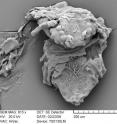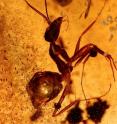Huge amber deposit discovered in India
Those who are proud to have a piece of amber that holds a little animal trapped in it maybe should not continue to read this. For what can be seen in the millions of years-old tree resin is almost always just a paper-thin façade. If sliced down the middle, you would find no more than a hollow space covered in some sort of "insect photo wallpaper." This does not apply to the amber Bonn paleontologist Professor Dr. Jes Rust and his colleagues have been looking at for two years. The lumps that resemble herbal cough drops are "full of it," containing numerous insect bodies, some of which are extremely well preserved, despite the fact that they have been there for 50 million years. Better yet: The petrified resin is also very easily convinced to release its contents again. "The amber has not been completely polymerized, allowing it to be dissolved easily," explains Rust. They have so far found more than 700 arthropods from 55 different genera – mostly insects, but also spiders, mites, and plant parts.
The dirty brown lumps come from the coast of the NW India's Gujarat province. Their contents cast a new light on the history of the sub-continent, which is said to have "broken off" from the East African land mass 160 million years ago to float through the oceans in isolation – at the high speed of about 20 centimeters per year. And only about 50 million years ago, India collided with Asia in a crash that caused the land to fold up into the Himalayas.
If that were true, India would have been completely isolated for 100 million years. This time should have been sufficient to give rise to a unique flora and fauna. The Indian amber was formed 53 million years ago. So it shows, similar to an old photo, what life looked like in India just before the collision with the Asian continent. This snapshot should then primarily show animal species that do not exist elsewhere.
Island-hopping before the big crash
But just that is not the case: Similar insect fossils as in Gujarat have also been found in Europe and even in Central America. "This indicates that there was a lively exchange of species before our amber formed," Rust thinks. There may have been long chains of volcanic islands on the border between the continental plates – just like in Japan or Indonesia today. The insect species in India and Asia could have mingled by "island-hopping" – and also many million years before the big crash. And from Asia, they would then have spread further.
But the amber itself also raises questions. While it happens rather frequently that plants or animals get stuck in tree resin and end up covered by it, they usually decay over time. "In our amber, however, some resin component seems to have preserved the insects," says Rust.
In addition, the resin obviously comes from the family of Dipterocarpaceae, which today has its main range in the Indo-Malayan region. Until now it was thought that this type of plant had its heyday 25 million years ago. Jes Rust comments, "The Indian amber proves that extensive tropical forests of Dipterocarpaceae must already have existed there more than 50 million years ago. That is a big surprise."
Source: University of Bonn
Articles on the same topic
- New trove of fossils suggests global distribution of tropical forest ecosystems in the EoceneMon, 25 Oct 2010, 19:51:56 UTC
Other sources
- 50 Million Year-Old Amber Trove Foundfrom CBSNews - ScienceThu, 28 Oct 2010, 2:30:37 UTC
- 50 Million Year-Old Amber Trove Foundfrom CBSNews - ScienceThu, 28 Oct 2010, 2:00:46 UTC
- 50 Million Year-Old Amber Trove Foundfrom CBSNews - ScienceTue, 26 Oct 2010, 12:50:50 UTC
- 50 Million Year-Old Amber Trove Foundfrom CBSNews - ScienceTue, 26 Oct 2010, 9:20:18 UTC
- Fossils in amber give clue to India's pastfrom UPITue, 26 Oct 2010, 0:00:32 UTC
- Observatory: Encased in Amber, a Trove of New Speciesfrom NY Times ScienceMon, 25 Oct 2010, 21:30:09 UTC
- Amber yields ancient bug haulfrom BBC News: Science & NatureMon, 25 Oct 2010, 20:10:24 UTC
- Prehistoric creatures discovered in huge Indian amber haulfrom The Guardian - ScienceMon, 25 Oct 2010, 19:50:35 UTC
- Huge amber deposit discovered in Indiafrom PhysorgMon, 25 Oct 2010, 19:50:29 UTC
- Insects in ancient amber reveal surprising tiesfrom MSNBC: ScienceMon, 25 Oct 2010, 19:40:10 UTC
- Insects in Ancient Amber Reveal Unexpected India-Asia Tiesfrom Live ScienceMon, 25 Oct 2010, 19:30:39 UTC
- In pictures: Insects in amber shed light on India's pastfrom The Guardian - ScienceMon, 25 Oct 2010, 19:20:27 UTC

